Simple Summary
Developing effective tools for the sustainable management of Tuta absoluta (Lepidoptera: Gelechiidae) remains a challenge. Pheromone-based control is attracting growing attention for managing this moth pest. In the present study, we assessed the efficacy of a mating disruption approach relying on biodegradable pheromone dispensers, tested at 300 and 500 dispensers/ha, for the control of T. absoluta on greenhouse tomato. The mating disruption strategy was coupled with a reference base treatment that alternates the most commonly used insecticides for the pest (the insecticide-based grower’s standard). Mating disruption with biodegradable dispensers achieved a significant reduction in T. absoluta male catches and leaf and fruit damages when compared to those obtained with the grower’s standard treatment alone, and performed better than commercial non-biodegradable dispensers. Overall, our study sheds light on the intriguing potential of biodegradable dispensers for T. absoluta management on greenhouse tomato.
Abstract
IPM approaches based on pheromone-based techniques for the management of the South American tomato pinworm, Tuta absoluta (Meyrick) (Lepidoptera: Gelechiidae), are of great interest. We evaluated the effectiveness of mating disruption (MD) experiments against T. absoluta using a biodegradable pheromone dispenser (Isonet-T TT BIOX234) in greenhouse-grown tomatoes over two years in southern Italy. A base treatment alternating the most used insecticides for the pest, i.e., the farmer treatment schedule (FTS), was assigned as a reference, and two MD dispenser densities (i.e., 300 and 500 dispensers/ha) were compared with the MD commercial product Isonet T at 1000 units/ha. We conducted two trials on crops at a density of 37,000 plants/ha. Pest flights were monitored in summer–autumn 2023 and 2024 with pheromone-baited Delta traps. The FTS ensured a generally low level of T. absoluta attacks (about 1 leaflet/leaf and 1/300 fruits). Even so, mating disruption resulted in further appreciable reductions in the presence and attacks of the target pest: 89%, 76% and 52% fewer catches; 61%, 45% and 37% fewer mined leaflets; and 76%, 59% and 54% fewer attacked fruits, for Isonet-T TT 500, Isonet-T TT 300 and Isonet T 1000, respectively. Overall, MD biodegradable dispensers could be a valuable tool for controlling T. absoluta in greenhouse-grown tomatoes, while also reducing plastic waste in the agricultural setting.
1. Introduction
The South American tomato pinworm, Tuta absoluta (Meyrick) (Lepidoptera: Gelechiidae), is a major pest of greenhouse and field tomatoes worldwide [1,2,3,4]. Although it can attack a range of species of the Solanaceae family, tomato (Solanum lycopersicum L.) is the preferred host [5]. Damage is caused by the larvae, which bore mines on the leaves and galleries inside the fruit and stems. Attacks on leaves cause economic damage only if the number of mines is high, while attacks on fruit almost always result in product waste [1,2,3,4]. In southern Italy, T. absoluta is active almost continuously throughout the year, given the mild winter and the widespread presence of protected crops, which facilitate the insect’s activity during the cold season. T. absoluta does not enter diapause and temperature has a major impact on its development cycle. Adult flights increase during spring and summer, peak in early autumn, then gradually decrease in October–November and drop sharply in December–January [6]. Without control measures, the pest population remains at a high density throughout most of the second half of the year. In South America, up to a dozen of generations per year have been observed [7]. Along the coastal areas of the Campania region (southern Italy), six to nine overlapping generations occur with life cycles ranging from 40 days for the first and eighth generations, to 28 days in the sixth generation, up to 60 days for the last generation, and 110 days for the overwintering generation [8].
Control of T. absoluta is currently achieved through Integrated Pest Management (IPM) approaches, including the use of chemical insecticides, biological control, and agronomic and cultural practices, as well as the use of pheromones for mass trapping and mating disruption [4,9]. Unfortunately, the need to use multiple treatments of synthetic insecticides for managing T. absoluta leads to the fast development of resistance in the targeted populations [10,11,12].
In this context, the use of non-chemical insecticide-based management tools, such as biopesticides, parasitoids and predators, along with mass trappings of male moths and pest-resistant plant cultivars can significantly contribute to reducing the risk of resistance development [13,14,15,16,17,18]. Earlier research outlined the efficacy of sex pheromone-based mating disruption (MD) for T. absoluta control both in greenhouse and open field tomatoes by using mixtures of the major pheromone component of the moth [19,20,21,22,23,24,25,26] (E,Z,Z)-3,8,11-tetradecatrien-1-yl acetate and the minor component of the pheromone (E,Z)-3,8- tetradecadienyl acetate or just the major component alone [27]. The low rate of parthenogenetic reproduction observed in T. absoluta [22] paves the way for the effective use of MD on this moth. However, recent research highlighted the importance of using this strategy as part of an IPM program in order to reduce the possible risk of an increase in the rate of parthenogenesis in target populations [22].
Several studies have been conducted in Mediterranean basin countries testing both hand-applied mating disruption (MD) dispensers (in protected cultivation in southwestern Sardinia, Italy [20], and in heated protected cultivation in the region of Chenchou, El Hamma, Gabes, Tunisia [24,25]) as well as pheromones applied with a caulking gun [23] in an open-field in the Meram district of Konya province, Turkey. In this study, we evaluated the effectiveness of MD with a biodegradable pheromone dispenser over a two-year period on tomatoes grown in greenhouses in southern Italy. As reference, a basic treatment was assigned that alternated the most used insecticides for the pest, i.e., the farmer treatment schedule (FTS), and two different application densities (300/ha and 500/ha dispensers Isonet-T TT BIOX234) were compared with the commercial product MD Isonet T at 1000 dispensers/ha.
2. Materials and Methods
2.1. Site and Crop Description
Two trials were conducted in the years 2023–2024 in a farm located in the province of Salerno, southern Italy (at Battipaglia, 40°35′04″ N, 15°58′14″ E, 40 m a.s.l., in 2023; at Eboli, 40°34′10″, 15°03′16″, in 2024), where T. absoluta attacks are frequently observed from spring to autumn. The host farmer, like most greenhouse tomato producers in the region, controls T. absoluta with several insecticide applications, alternating between chemicals and biopesticides (Table 1 and Table 2) at short intervals during the crop cycle. The trial crops of the cultivar Dardo were transplanted on mulched soil on June 28 in 2023 and on May 24 in 2024, at a density of about 37,000 plants/ha. Plants were trained to a single stem fastened to vertical wires. Irrigation and fertilization were performed with a drip system. The crops were terminated on December 10 in 2023 and on October 7 in 2024.

Table 1.
Formulates employed for managing Tuta absoluta in the field trials.

Table 2.
Details of the farmer’s treatment schedules carried out in this study.
2.2. Isonet Devices
The commercial Isonet T and the experimental Isonet-T TT BIOX234, both supplied by Shin-Etsu Chemical Co. Ltd., (Tokyo, Japan), are hand-applied reservoir pheromone dispensers containing the T. absoluta sex pheromone [(E,Z,Z)-3,8,11-tetradecatrien-1-yl acetate and (E,Z)-3,8-tetradecadie-yl acetate] [27]. Isonet T is made of plastic polymers and consists of two tubes, one filled with the T. absoluta pheromone and the other containing an aluminum wire for the positioning of the dispenser in the greenhouse. Isonet-T TT BIOX234 consists of two parallel capillary tubes of biodegradable polymers joined and sealed at the ends, both filled with the T. absoluta synthetic sex pheromone.
2.3. Treatments
Four treatments against T. absoluta were compared, all including the insecticide spraying program used in the farm (FTS): (1) FTS only; (2) FTS and Isonet T at a density of 1000 units/ha (IT1000); (3) FTS and Isonet-T TT BIOX234 at a density of 300 units/ha (ITX300); (4) FTS and Isonet-T TT BIOX234 at a density of 500 units/ha (ITX500). FTS consisted of 13 sprays in 2023, from July 3 (five days after transplanting) to October 18, and of 9 sprays in 2024, from June 24 (31 days after transplanting) to August 4, alternating between 7 and 10 insecticides (Table 1 and Table 2). The FTS program was aimed at controlling (i) Frankliniella occidentalis (Pergande) with the first applications, to reduce the risk of early viral infections, and (ii) various lepidopteran pests, such as Spodoptera littoralis (Boisduval), Helicoverpa armigera (Hübner) and Chrysodeixis chalcites (Esper). Synthetic chemicals (chlorantraniliprole, emamectin benzoate, acibenzolar-s-methyl, cyantraniliprole) were used when an increase in the moth population was expected (July), while Bacillus thuringiensis-based preparations were used later, when synthetic chemicals are not permitted.
Treatments were assigned to unreplicated plots of about 2000 m2 in 2023 and 4000 m2 in 2024, each consisting of a multi-tunnel cold greenhouse of 8 tunnels in 2023 and 16 tunnels in 2024, with a maximum height of 5 m (Figure 1).
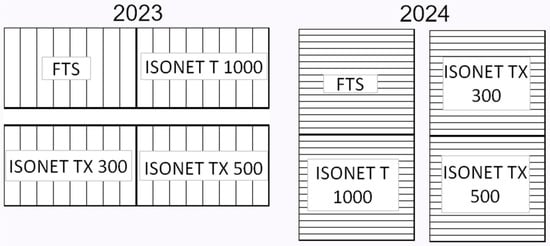
Figure 1.
Plot layout of the trials.
Plots ITX500 and ITX300 were part of a multi-tunnel greenhouse 10 m away from the greenhouse with plots IT1000 and FTS; both greenhouses were fenced on all sides with high transmittance, high greenhouse effect polyethylene film (Lirsalux super type) and insect-proof nets (20 × 10 threads/cm2). The plots of the same multi-tunnel (ITX500 and IX300; IT1000 and FTS) were separated only by the fence, which limited air mixing between the two halves of the multi-tunnel. The greenhouses did not have double doors. Ventilation was ensured by openings in the roof, which were also covered by insect-proof nets. Temperature and relative humidity during the trials were monitored with dataloggers (Elitech RC-5, Elitech Technology, Inc., San Jose, CA, USA) placed at 1.5 m height in the greenhouses. The greenhouse complex was bounded by a tomato field of about 25 ha. All Isonet dispensers were placed two days before crop transplanting and evenly distributed according to the application rate by twisting them to the crop support wires at a height of 2 m. The insecticide solutions were prepared shortly before field application and sprayed with a pneumatic atomizer (Caffini 600 L model, Caffini S.p.A., Verona, Italy), using a water volume of 1000 L/ha to ensure a thorough wetting of the plants. After each application, the spray equipment was thoroughly washed and rinsed with water.
2.4. Pest Monitoring
The effectiveness of pheromone dispensers in disrupting sexual communication of T. absoluta was evaluated by monitoring the flight activity of males and the crop damage.
Tuta absoluta male flights were monitored throughout the entire tomato crop cycle, from 26 June to 30 November 2023, and from 22 May to 6 October 2024, with a Biogard Delta trap (BDT) baited with T. absoluta pheromone (CBC Biogard, Grassobbio, Italy), placed 1.8 m above the ground in the center of each plot on the same day when Isonet dispensers were placed. Traps were checked weekly, while pheromone dispensers were replaced every 4–5 weeks and sticky trap bottoms changed as needed. Male catches in the disrupted plots were compared with those recorded in the FTS plot.
2.5. Leaf and Fruit Damage Estimation
Efficacy assessment was estimated indirectly by counting the number of mined leaflets on two medium-high leaves (20 leaflets/leaf on average) and the number of infested fruits in 25 clusters (six fruits/cluster on average) of three plants for each of ten equally spaced positions along the two central tunnels of the plots. Observations were made at intervals of approximately ten days, eight times in 2023 (every ten days from August 26 to November 4) and six times in 2024 (every ten days from August 17 to October 6), from the appearance of the first symptoms of T. absoluta attacks until the end of harvest. Leaflets and fruits were considered damaged if they had at least one epidermis erosion (mine) or hole and were removed after assessment.
2.6. Data Analysis
Incidence rates of mined leaflets (number per leaf) and of damaged fruits (number per cluster) were summarized as averages per trial, treatment and sub-plot position. For the inference of average treatment effects (long-run means and related contrasts), a Poisson distribution was fitted to summary counts by treatment and trial, with the logarithm of the parameter as a linear function of treatments and the logarithm of the number of inspected organs as exposure offset, with coefficients starting from a Student distribution covering plausible ranges. Distributions of expected incidence rates per treatment and of related contrasts were computed from simulated distributions of the model coefficients. The analysis was performed with the R programming language [28] and extensions [29,30,31].
3. Results
3.1. Male Captures
Catches demonstrated the good specificity of the pheromones used, consisting almost exclusively of T. absoluta individuals, with occasional occurrence of the species H. armigera and S. littoralis (Lepidoptera: Noctuidae). Males were captured from late July to late November in 2023 and from mid-July to early October in 2024, with most catches occurring from mid-September to the second week of November in 2023 and from September to the first week of October, but mostly in the latter week, in 2024. Total catches varied considerably between the different treatments and between the years of testing, with the FTS treatment yielding twice as much as the combined total of the three Isonet treatments in 2023 (290 vs. 149) and slightly more in 2024 (884 vs. 819), a year in which the number of catches was almost four times higher than in 2023 (1703 vs. 439), albeit over a much shorter time interval (Figure 2). Among Isonet treatments, catches were highest for IT1000 and lowest for ITX500 in both years.
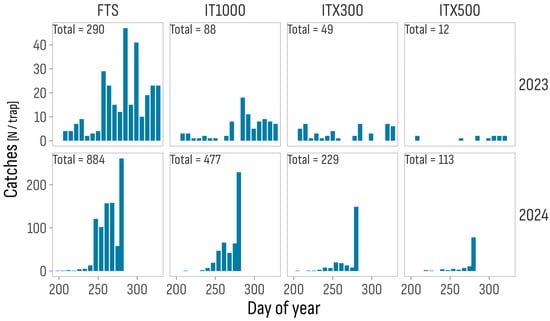
Figure 2.
Catches of flying T. absoluta adults per day of the year, treatment, and trial year. FTS: Farmer’s treatment schedule of 13 sprays in 2023, from July 3 to October 18, and of 9 sprays in 2024, from June 24 to August 4, with bio- and synthetic insecticides; IT1000: FTS + Isonet T at 1000 pheromone dispensers/ha; ITX300 and ITX500: FTS + Isonet-T TT BIOX234 at 300 and 500 pheromone dispensers/ha.
3.2. Incidence of Mined Leaflets and Damaged Fruits
In the 2023 trial, the first signs of the pest attack (mines on leaflets) were observed in late August, on fully developed plants with ripening fruits; the average incidence per 100 leaves was 7 for ITX500, 10 for ITX300, 8 for IT1000 and 17 for FTS (Figure 3). Average incidence of mined leaflets per 100 leaves increased later, moderately for Isonet treatments and considerably for FTS, peaking at 53 for ITX500, 73 for ITX300, 85 for IT1000 and 133 for FTS.
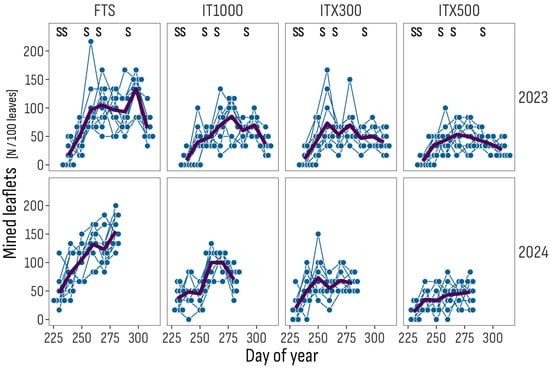
Figure 3.
Trend of the incidence of mined leaflets by sub-plot position (gray points and thin lines) and averages (thick lines) per day of the year, treatment and trial year. The S symbol marks occurrences of insecticide sprays. FTS: Farmer’s treatment schedule of 13 sprays in 2023, from July 3 to October 18, and of 9 sprays in 2024, from June 24 to August 4, with bio- and synthetic insecticides; IT1000: FTS + Isonet T at 1000 pheromone dispensers/ha; ITX300 and ITX500: FTS + Isonet-T TT BIOX234 at 300 and 500 pheromone dispensers/ha.
In 2024, the trial started about one month earlier than in 2023 and mined leaflets were first observed toward the end of the second decade of August (day of year: 230), with average incidences per 100 leaves of 13 for ITX500, 20 for ITX300, 37 for IT1000 and 47 for FTS (Figure 3, Supplementary Material Tables S1 and S2). The incidence increased during September, with the number per 100 leaves peaking at 48 for ITX500, 73 for ITX300, 100 for IT1000 and 155 for FTS.
In both trials, fruit damage symptoms were observed later than leaf mines, by about 40 days in 2023 and 30 days in 2024. No damage by other pests (e.g., H. armigera) was detected during the trials. Ranges of average incidences of damaged fruits per 100 clusters in the 2023 and 2024 years were, respectively: 7–10 and 4–5 for ITX500; 8–16 and 8–12 for ITX300; 11–16 and 10–14 for IT1000; 23–47 and 9–30 for FTS (Figure 4).
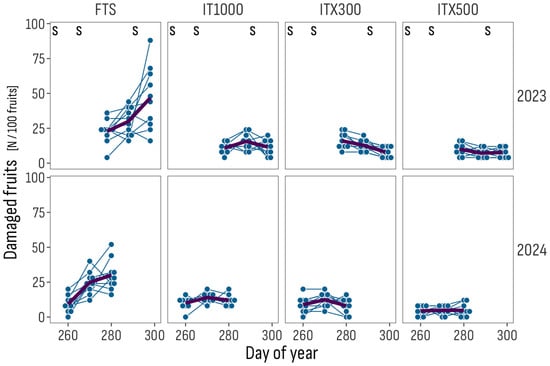
Figure 4.
Trend of the incidence of damaged fruits by sub-plot position (points and thin lines) and averages (thick lines) per day of the year, treatment and trial year. The S symbol marks occurrences of insecticide sprays. FTS: Farmer’s treatment schedule of 13 sprays in 2023, from July 3 to October 18, and of 9 sprays in 2024, from June 24 to August 4, with bio- and synthetic insecticides; IT1000: FTS + Isonet T at 1000 pheromone dispensers/ha; ITX300 and ITX500: FTS + Isonet-T TT BIOX234 at 300 and 500 pheromone dispensers/ha.
Overall, the average incidences of leaf and fruit damage were low, not exceeding three leaflets on two leaves and one fruit on two clusters, as might be expected from the uniform schedule of frequent sprays, which ended two weeks before the first observation in 2024, while covering most of the observation interval in 2023. Nevertheless, in both years, a significant reduction in infestation was achieved with MD devices, with Isonet-T TT BIOX234 achieving a greater reduction than Isonet T (Figure 5).
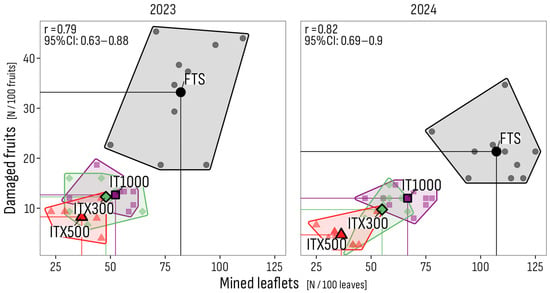
Figure 5.
Pearson correlations between average incidences across assessments of mined leaflets and damaged fruits. The correlation across trials was 0.65 (95% CI: 0.5–0.76). Sub-plot positions (points) and averages (circled points marked by treatment names) per treatment and trial year, with enveloping polygons per treatment (FTS: gray; IT1000: pink; ITX300: green; ITX500: red). FTS: Farmer’s treatment schedule of 13 sprays in 2023, from July 3 to October 18, and of 9 sprays in 2024, from June 24 to August 4, with bio- and synthetic insecticides; IT1000: FTS + Isonet T at 1000 pheromone dispensers/ha; ITX300 and ITX500: FTS + Isonet-T TT BIOX234 at 300 and 500 pheromone dispensers/ha.
3.3. Relationship Between Male Catches and Damages
In both years, the incidence of leaf and fruit damage was positively correlated with the total frequency of male catches, with 100 more catches corresponding to 16 more mined leaflets per 100 leaves and 9 more damaged fruits per 100 clusters in 2023, and 9 more mined leaflets and 2 more damaged fruits per 100 leaves and clusters, respectively, in 2024 (Figure 6).
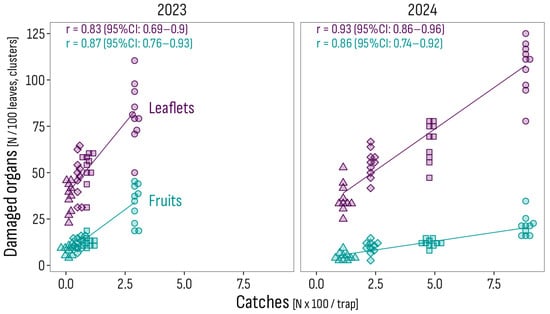
Figure 6.
Pearson correlations between the number of catches and the incidence of mined leaflets and of damaged fruits per trial year. The correlations across trials were 0.82 (95% CI: 0.74–0.88) for the incidence of mined leaflets and 0.39 (95% CI: 0.19–0.56) for the incidence of damaged fruits. Treatments marked by symbols: FTS (circle); IT1000 (square); ITX300 (diamond); ITX500 (triangle). FTS: Farmer’s treatment schedule of 13 sprays in 2023, from July 3 to October 18, and of 9 sprays in 2024, from June 24 to August 4, with bio- and synthetic insecticides; IT1000: FTS + Isonet T at 1000 pheromone dispensers/ha; ITX300 and ITX500: FTS + Isonet-T TT BIOX234 at 300 and 500 pheromone dispensers/ha.
3.4. Expected Values
The expected values (long-run means for the trial conditions) of the incidence of mined leaflets and of damaged fruits per treatment, as well as the percent differences in expected values between pairs of treatments, are represented in Figure 7 by 80% and 95% credible intervals of plausible values.
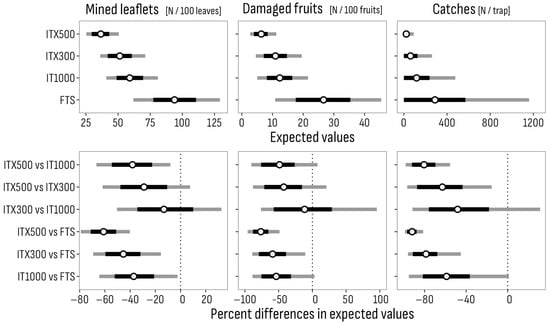
Figure 7.
Central positions (circular points) and 80% (black bars) and 95% (gray bars) highest-density intervals of expected values and of related pairwise percent differences of the incidence of mined leaflets and damaged fruits and of the number of captures of flying adults per treatment (long-run means for identical experimental conditions). FTS: Farmer’s treatment schedule of 13 sprays in 2023, from July 3 to October 18, and of 9 sprays in 2024, from June 24 to August 4, with bio- and synthetic insecticides; IT1000: FTS + Isonet T at 1000 pheromone dispensers/ha; ITX300 and ITX500: FTS + Isonet-T TT BIOX234 at 300 and 500 pheromone dispensers/ha.
The credible intervals for the ITX300 and the IT1000 treatments overlap with their upper half at the lower part of those for the FTS treatment, while the interval for ITX500 is lower and completely outside. The expected values for male catches differ similarly between treatments, though the distributions of plausible values all overlap toward low values (Figure 7).
Plausible values for the percentage differences in expected incidence values between the Isonet treatments and the reference FTS are well in the negative side for both mined leaflets and damaged fruits, and male catches, with intervals of incidence reductions between zero and 80% for mined leaflets and between zero and 90% for damaged fruits and male catches. Among the Isonet treatments, the differences in the plausible percentage intervals between ITX300 and IT1000 are mostly in the negative range for the incidence of mined leaflets, damaged fruits and male catches, but also with portions of positive values, particularly for fruit damage, showing a slightly higher expected efficacy for ITX300. Intervals for differences between ITX500 and ITX300 show a moderately higher expected efficacy in leaf and fruit damage control and a higher efficacy in male captures for ITX500, while the efficacy of ITX500 is expected to be generally higher than IT1000.
4. Discussion
Although the use of MD products against T. absoluta has become increasingly popular in recent years in several regions of the world [4,32,33], to our knowledge, this is the first research focusing on biodegradable dispensers. The trial site offers very favorable conditions for T. absoluta, with a mild climate and large areas cultivated in cold plastic greenhouses, which allow harmful populations of the pest to develop and remain active during the cold season [8], while the natural enemies of this moth are limited by widespread intensive growing conditions (e.g., large amounts of chemicals). Given the need for large plots for disruption trials, a treatment with Isonet devices alone (without insecticide interventions) or with on-site replications on the commercial farm hosting the trial was not possible. However, similar results obtained in the two-year trial with Isonet, under different seasonal conditions and pest population densities, showed a remarkable enhancement in control efficacy compared to the spraying program alone.
In both years, male captures increased in the second half of the crop cycle (from mid-September in 2023 and from late August in 2024), probably due to the non-use of chemical sprays during harvest. The lower density of T. absoluta population in the 2023 trial could have been due in part to seasonal fluctuations, but mostly to strict control practices in the surrounding area of intensive, protected vegetable cultivation, leading to a higher containment of the pest population in the environment, compared to the more diversified agricultural landscape of the 2024 trial location. The frequency of catches in Isonet plots was consistently lower than in the FTS plot, with the lowest values and no catches in the first two months of monitoring for ITX500 compared to ITX300 and IT1000. Damage levels were positively correlated with total catches. The incidence of damage was significantly higher in 2023 than in 2024, probably due to later transplanting (June 28 vs. May 24) that exposed the crop to the pest when its population peaks in the area [6]. The FTS treatment ensured a low level of T. absoluta damage, averaging less than one leaflet per leaf and less than one fruit in 350 clusters, with larval activity ending before the end of adult flights. This level of leaf and fruit damage was further reduced with Isonet treatments, respectively, by 37% and 55% with IT1000, by 45% and 60% with ITX300, and by 61% and 76% with ITX500. Isonet T has been already tested in southern Italy at rates of 600 and 1000 dispensers/ha, also with promising control effectiveness of T. absoluta [34], but when applied at the higher dose in our trials it was always outperformed by Isonet-T TT BIOX234, consistently at 500 and, to a lesser extent, at 300 dispensers/ha. The positive performance of Isonet treatments could be partly due to the low density of the pest population, thanks to the knockdown effect of early insecticide sprays (spinosad, chlorantraniliprole), which prevented the population from developing.
The control levels obtained with Isonet T at the rate of 1000 dispensers/ha agree with those of similar trials conducted in southwestern Sardinia (Italy), where reductions of 93–97% in male catches, 57–85% in leaf damage, and 62–89% in fruit damage were observed in disrupted greenhouses, compared to the control [20]. Tested at rates of 500, 750 and 1000 dispensers/ha in protected tomato crops in Kuwait, Isonet T was as effective at the highest rate as the insecticide control program based on three applications of flubendiamide, in May–July, and six applications, first with flubendiamide and then with azadirachtin, in December–February (flubendiamide: 60 mg L−1; azadirachtin: 3 g L−1) [21].
In a heated greenhouse in Tunisia, Isonet T applied alone at a rate of 1000 dispensers/ha showed control rates comparable to those obtained when combined with monthly bioinsecticide sprays (based on B. thuringiensis ssp. kurstaki and Azadirachta indica A.Juss., at rates of 3 kg-L/ha) and to those obtained with a specialized pheromone and lure application technology (SPLAT TUTA). The latter involves the use of a pheromone gel mixed with the insecticide spinosad at the rate of 17 mL/kg of pheromone (attract-and-kill technique), applied weekly at the rate of 1 g/point to the axil of an upper leaf once the plant had reached 1 m in height [25]. On the other hand, TUTATEC passive dispensers of the sex pheromone mixture (E,Z,Z)-3,8,11-tetradecatrienyl acetate and (E,Z)-3,8-tetradecadienyl acetate (SEDQ Healthy Crops SL, Barcelona, Spain), applied at 600 dispensers/ha (111 g a.i. of sex pheromone/ha) to an early spring tomato crop in heated greenhouses in southern Tunisia, reduced leaf and fruit infestation by 29% and 36%, respectively, compared to 32% and 72% obtained with insecticide control alone [24]. The latter consisting of two applications with azadirachtin (10 g/L) and one application with cyantraniliprole (100 g/L) at doses of 3 L/ha and 0.6 L/ha, respectively.
In Spain, Vacas et al. (2011) [19] evaluated mesoporous pheromone dispensers at different doses (10 to 40 g a.i./ha), emitted at a constant rate over four months, finding that MD provided pest control levels comparable to that obtained with chemical control alone (three applications of indoxacarb 30% at doses of 100 g/ha, alternated with one application of spinosad 480 g/L at the dose of 300 g/ha), only when MD was applied in a greenhouse protected by a double door and a fine mesh net. In a two-year experiment conducted in Turkey (Konya province) under open-field conditions, where the weather influence on pheromone dispersal is higher and the attraction of adults from the surrounding areas is continuous, application of the SPLAT TUTA technology with a pheromone gel at 2500 g/ha reduced T. absoluta infestation by 63% and 75% [23]. Recently, in an experiment conducted on protected tomato crops in Ningcheng, Inner Mongolia and in Youjun Town, Sichuan, both passive polyethylene tube dispensers and active pheromone aerosol devices at various rates showed a significant reduction in damage rates and larval populations [26].
In conclusion, mating disruption applied with biodegradable pheromone dispensers can play a useful role in protecting greenhouse tomato crops from T. absoluta, allowing a reduction in insecticide sprays and related residues in products, with costs partially offset by the reduction in insecticide application costs. Protected cultivations are particularly suitable for the mating disruption technique and there is ample prospect for its application in table tomatoes, which are mostly produced in greenhouses.
Supplementary Materials
The following supporting information can be downloaded at: https://www.mdpi.com/article/10.3390/insects16101035/s1, Table S1: Percent reduction of the incidence of mined leaflets and damaged fruits with mating disruption (MD) vs. the insecticide spraying program used in the farm (FTS) by treatment and observation in the 2023 trial; Table S2: Percent reduction of the incidence of mined leaflets and damaged fruits with mating disruption (MD) vs. the insecticide spraying program used in the farm (FTS) by treatment and observation in the 2024 trial.
Author Contributions
Conceptualization, L.S.; methodology, L.S. and G.P.; software, L.S.; validation, G.B., A.C. and A.L.; investigation, L.S. and G.P.; resources, L.S.; data curation, L.S. and G.P.; writing—original draft preparation, L.S., G.B. and A.L.; writing—review and editing, A.C.; visualization, G.B., G.P., A.C. and A.L.; supervision, L.S., A.C. and A.L.; funding acquisition, L.S. All authors have read and agreed to the published version of the manuscript.
Funding
The authors have not disclosed any funding.
Data Availability Statement
Data are available in the manuscript; the whole dataset can be requested to the authors.
Acknowledgments
We are grateful to Shin-etsu Chemical Co. and CBC (Europe) s.r.l. for kindly providing us the pheromone dispensers used in the trials. We are grateful to Needhi K. Thangasamy (University of Pisa, Italy) for her kind revision of the English of our manuscript. We also thank Francesco Savino for his kind assistance during field experiments.
Conflicts of Interest
The authors declare no conflicts of interest. Mention of trade names or commercial products in this article is solely for the purpose of providing specific information and does not imply recommendation or endorsement by the authors’ institutions.
References
- Biondi, A.; Guedes, R.N.C.; Wan, F.-H.; Desneux, N. Ecology, Worldwide Spread, and Management of the Invasive South American Tomato Pinworm, Tuta absoluta: Past, Present, and Future. Annu. Rev. Entomol. 2018, 63, 239–258. [Google Scholar] [CrossRef]
- Mansour, R.; Brévault, T.; Chailleux, A.; Cherif, A.; Grissa-Lebdi, K.; Haddi, K.; Mohamed, S.A.; Nofemela, R.S.; Oke, A.; Sylla, S.; et al. Occurrence, Biology, Natural Enemies and Management of Tuta absoluta in Africa. Entomol. Gen. 2018, 38, 83–112. [Google Scholar] [CrossRef]
- Han, P.; Bayram, Y.; Shaltiel-Harpaz, L.; Sohrabi, F.; Saji, A.; Esenali, U.T.; Jalilov, A.; Ali, A.; Shashank, P.R.; Ismoilov, K.; et al. Tuta absoluta Continues to Disperse in Asia: Damage, Ongoing Management and Future Challenges. J. Pest Sci. 2019, 92, 1317–1327. [Google Scholar] [CrossRef]
- Desneux, N.; Han, P.; Mansour, R.; Arnó, J.; Brévault, T.; Campos, M.R.; Chailleux, A.; Guedes, R.N.C.; Karimi, J.; Konan, K.A.J.; et al. Integrated Pest Management of Tuta absoluta: Practical Implementations across Different World Regions. J. Pest Sci. 2022, 95, 17–39. [Google Scholar] [CrossRef]
- Cherif, A.; Attia-Barhoumi, S.; Mansour, R.; Zappalà, L.; Grissa-Lebdi, K. Elucidating Key Biological Parameters of Tuta absoluta on Different Host Plants and under Various Temperature and Relative Humidity Regimes. Entomol. Gen. 2019, 39, 1–7. [Google Scholar] [CrossRef]
- Sannino, L.; Piro, F.; Espinosa, B.; Pentangelo, A.; Pesapane, G.; Griffo, R.; Tropiano, F.G.; Caponero, A. Tuta absoluta, stagionalità dei voli ed efficacia dei sistemi di cattura. L’Infor. Agr. 2013, 69, 51–55. [Google Scholar]
- Barrientos, Z.; Aplabaza, H.; Norero, S.; Estay, P. Threshold Temperature and Thermal Constant for Development of the South American Tomato Moth, Tuta absoluta (Lepidoptera: Gelechiidae). Cien. Inv. Agr. 1998, 25, 133–137. [Google Scholar] [CrossRef]
- Sannino, L. Inquadramento Sistematico e Aspetti Morfo-Biologici di Tuta absoluta (Meyrick) (Lepidoptera, Gelechiidae). Atti Accad. Naz. Ital. Entomol. 2012, 2012, 67–75. [Google Scholar]
- Han, P.; Zhang, Y.; Arnó, J.; Mansour, R. Research toward Enhancing Integrated Management of Tuta absoluta, an Ongoing Invasive Threat in Afro-Eurasia. Entomol. Gen. 2024, 44, 263–267. [Google Scholar] [CrossRef]
- Guedes, R.; Siqueira, H.A.A. The Tomato Borer Tuta absoluta: Insecticide Resistance and Control Failure. CABI Rev. 2012, 2012, 1–7. [Google Scholar] [CrossRef]
- Roditakis, E.; Steinbach, D.; Moritz, G.; Vasakis, E.; Stavrakaki, M.; Ilias, A.; García-Vidal, L.; del Rosario Martínez-Aguirre, M.; Bielza, P.; Morou, E.; et al. Ryanodine Receptor Point Mutations Confer Diamide Insecticide Resistance in Tomato Leafminer, Tuta absoluta (Lepidoptera: Gelechiidae). Insect Biochem. Mol. Biol. 2017, 80, 11–20. [Google Scholar] [CrossRef]
- Guedes, R.; Roditakis, E.; Campos, M.; Haddi, K.; Bielza, P.; Siqueira, H.; Tsagkarakou, A.; Vontas, J.; Nauen, R. Insecticide Resistance in the Tomato Pinworm Tuta absoluta: Patterns, Spread, Mechanisms, Management and Outlook. J. Pest Sci. 2019, 92, 1329–1342. [Google Scholar] [CrossRef]
- Cabello, T.; Vila, E. Biological Control of the South American Tomato Pinworm, Tuta absoluta (Lep.: Gelechiidae), with Releases of Trichogramma achaeae (Hym.: Trichogrammatidae) in Tomato Greenhouses of Spain. IOBC/Wprs Bull. 2009, 49, 225–230. [Google Scholar]
- González-Cabrera, J.; Mollá, O.; Montón, H.; Urbaneja, A. Efficacy of Bacillus thuringiensis (Berliner) in Controlling the Tomato Borer, Tuta absoluta (Meyrick) (Lepidoptera: Gelechiidae). BioControl 2011, 56, 71–80. [Google Scholar] [CrossRef]
- Abbes, K.; Brahim, C. Failure of the Biological Control of Tuta absoluta Using the Predator Nesidiocoris tenuis in a Protected Tomato Crop: Analysis of Factors. IOBCWPRS Bull. 2012, 80, 231–236. [Google Scholar]
- Braham, M. Sex Pheromone Traps for Monitoring the Tomato Leafminer, Tuta absoluta: Effect of Colored Traps and Field Weathering of Lure on Male Captures. Res. J. Agric. Environ. Manag. 2014, 3, 290–298. [Google Scholar]
- Camargo, R.A.; Barbosa, G.O.; Possignolo, I.P.; Peres, L.E.P.; Lam, E.; Lima, J.E.; Figueira, A.; Marques-Souza, H. RNA Interference as a Gene Silencing Tool to Control Tuta absoluta in Tomato (Solanum lycopersicum). PeerJ 2016, 4, e2673. [Google Scholar] [CrossRef]
- Aynalem, B. Tomato Leafminer [(Tuta absoluta Meyrick) (Lepidoptera: Gelechiidae)] and Its Current Ecofriendly Management Strategies: A Review. J. Agric. Biotechnol. Sustain. Dev. 2018, 10, 11–24. [Google Scholar] [CrossRef]
- Vacas, S.; Alfaro, C.; Primo, J.; Navarro-Llopis, V. Studies on the Development of a Mating Disruption System to Control the Tomato Leafminer, Tuta absoluta Povolny (Lepidoptera: Gelechiidae). Pest Manag. Sci. 2011, 67, 1473–1480. [Google Scholar] [CrossRef]
- Cocco, A.; Deliperi, S.; Delrio, G. Control of Tuta absoluta (Meyrick) (Lepidoptera: Gelechiidae) in Greenhouse Tomato Crops Using the Mating Disruption Technique. J. Appl. Entomol. 2013, 137, 16–28. [Google Scholar] [CrossRef]
- Jallow, M.F.A.; Dahab, A.A.; Albaho, M.S.; Devi, V.Y.; Jacob, J.; Al-Saeed, O. Efficacy of Mating Disruption Compared with Chemical Insecticides for Controlling Tuta absoluta (Lepidoptera: Gelechiidae) in Kuwait. Appl. Entomol. Zool. 2020, 55, 213–221. [Google Scholar] [CrossRef]
- Grant, C.; Jacobson, R.; Bass, C. Parthenogenesis in UK Field Populations of the Tomato Leaf Miner, Tuta absoluta, Exposed to the Mating Disruptor Isonet T. Pest Manag. Sci. 2021, 77, 3445–3449. [Google Scholar] [CrossRef]
- Ünlü, L.; Ögür, E.; Uulu, T.E. Control of Tuta absoluta (Meyrick) (Lepidoptera: Gelechiidae) in Open Field Tomato Crops Using the Mating Disruption Technique. Phytoparasitica 2021, 49, 385–396. [Google Scholar] [CrossRef]
- Chouikhi, S.; Assadi, B.H.; Abbes, K.; Bkhiti, I.; Grissa Lebdi, K.; Belkadhi, M.S. Effectiveness of Mating Disruption with TUTATEC® Dispensers against Tuta absoluta (Lepidoptera: Gelechiidae) in Heated Greenhouses in Southern Tunisia. Phytoparasitica 2023, 51, 273–283. [Google Scholar] [CrossRef]
- Chouikhi, S.; Assadi, B.H.; Ettaib, R.; Lebdi, K.G.; Belkadhi, M.S. Effectiveness of Mating Disruption Applied Alone or in Combination with Bioinsecticides against Tuta absoluta in Heated Greenhouse Tomato Crops of Southern Tunisia. Phytoparasitica 2023, 51, 521–532. [Google Scholar] [CrossRef]
- Huang, J.; Wu, E.; Yang, C.; Han, X.; Zhang, J.; Cao, M.; Deng, F.; Guo, Q.; Du, Y. Mating Disruption of the Tomato Leafminer Tuta absoluta (Lepidoptera: Gelechiidae) on Greenhouse Tomatoes. Crop Health 2024, 2, 15. [Google Scholar] [CrossRef]
- Michereff Filho, M.; Vilela, E.F.; Jham, G.N.; Attygalle, A.; Svatos, A.; Meinwald, J. Initial Studies of Mating Disruption of the Tomato Moth, Tuta absoluta (Lepidoptera: Gelechiidae) Using Synthetic Sex Pheromone. J. Braz. Chem. Soc. 2000, 11, 621–628. [Google Scholar] [CrossRef]
- R Core Team. R: A Language and Environment for Statistical Computing; R Foundation for Statistical Computing: Vienna, Austria, 2025; Available online: https://www.R-project.org (accessed on 14 April 2025).
- Bürkner, P.-C. Advanced Bayesian Multilevel Modeling with the R Package Brms. R J. 2018, 10, 395–411. [Google Scholar] [CrossRef]
- Barrett, T.; Dowle, M.; Srinivasan, A.; Gorecki, J.; Chirico, M.; Hocking, T.; Schwendinger, B.; Krylov, I.; Stetsenko, I.; Short, T.; et al. Data.Table: Extension of “data.Frame” (Version 1.16.0). 2024. Available online: https://cran.r-project.org/web/packages/data.table/index.html (accessed on 14 April 2025).
- Wickham, H.; Chang, W.; Henry, L.; Pedersen, T.L.; Takahashi, K.; Wilke, C.; Woo, K.; Yutani, H.; Dunnington, D.; van den Brand, T.; et al. Ggplot2: Create Elegant Data Visualisations Using the Grammar of Graphics. 2025. Available online: https://cran.r-project.org/web/packages/ggplot2/index.html (accessed on 14 April 2025).
- Giorgini, M.; Guerrieri, E.; Cascone, P.; Gontijo, L. Current Strategies and Future Outlook for Managing the Neotropical Tomato Pest Tuta absoluta (Meyrick) in the Mediterranean Basin. Neotrop. Entomol. 2019, 48, 1–17. [Google Scholar] [CrossRef]
- Wang, M.; Ismoilov, K.; Liu, W.; Bai, M.; Bai, X.; Chen, B.; Chen, H.; Chen, H.; Dong, Y.; Fang, K.; et al. Tuta absoluta Management in China: Progress and Prospects. Entomol. Gen. 2024, 44, 269–278. [Google Scholar] [CrossRef]
- Sannino, L.; Piro, F.; Proto, S.; Savino, F.; Griffo, R.; Conte, A.; Punzi, F. Efficacia Di Isonet T, Un Nuovo Sistema per il Contenimento di Tuta absoluta Mediante Confusione Sessuale. Atti Gior. Fitop. 2014, 2014, 193–200. [Google Scholar]
Disclaimer/Publisher’s Note: The statements, opinions and data contained in all publications are solely those of the individual author(s) and contributor(s) and not of MDPI and/or the editor(s). MDPI and/or the editor(s) disclaim responsibility for any injury to people or property resulting from any ideas, methods, instructions or products referred to in the content. |
© 2025 by the authors. Licensee MDPI, Basel, Switzerland. This article is an open access article distributed under the terms and conditions of the Creative Commons Attribution (CC BY) license (https://creativecommons.org/licenses/by/4.0/).